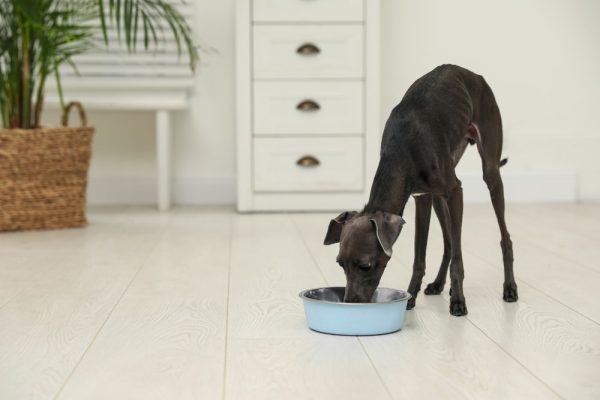- This article has been reviewed for factual accuracy and completeness by a qualified veterinarian. It should be taken as a guide for food safety and not replace dietary advice tailored to your pet, by your veterinarian. Dog owners are urged to consult with their veterinarian when making dietary decisions for their pet.
One of the biggest worries for many owners is how to create a proper diet for their dogs so they can have plenty of energy while maintaining an ideal weight. With so many different brands available, it’s not easy to sort through them all, and then there’s wet and dry food to choose between. Since many dry food brands are available in large bags and are often less expensive than wet food, many people might wonder if they can feed only dry food to their dogs. While the short answer is yes, there are several factors to consider, so keep reading as we look at the pros and cons of a dry diet to help you make an informed decision.

Why Can Dogs Eat Only Dry Food?
The main reason that it is possible to keep your pet on a dry-food-only diet is that it provides complete and balanced nutrition for your pet that will help keep them healthy. Each serving of dry food will contain all the nutrients, vitamins, and minerals that your pet requires from one day to the next without any need to add supplements outside of water.

Benefits of Eating Only Dry Food
Dental Hygiene
Feeding your dog a dry-food-only diet can help keep their teeth cleaner, as the crunchy kibble helps scrape away the plaque that builds up on the teeth. Since dental health is a major concern for dogs all across the United States, with more than 80% of dogs older than three years old suffering some form of dental disease, it makes sense to take every precaution that you can to guard against it.

Convenience
Dry dog food comes in large bags, has a long shelf life, and is easy to store. It’s also much easier to open than cans, and it won’t spoil in the bowl, so it’s often more convenient for pet owners, especially those with a busy schedule.
Cost-Effectiveness
Dry dog food is often much less expensive than wet food, which can make it a more budget-friendly option. Especially for someone with a large breed or several dogs to care for.
Cleanliness
Dry dog food is usually easier to clean up than wet food after your pet has finished eating.

Disadvantages of Eating Only Dry Food
Hydration
Dry food will not help keep your dog hydrated, so it is essential that you pay attention to their water intake and provide access to plenty of fresh, clean water.
Health Issues
Some dogs with health issues may not be able to cope with dry food. It can be harder for your dog to chew if they have oral diseases like periodontal disease, oral tumors, or wounds in the mouth. If your dog appears to have difficulty with dry food, they could have some form of dental pain. And while giving soft food is an okay short term solution, you should consult with a veterinarian for a plan to help your dog.

Risk of Obesity
A major concern about dry food is that it contains a large amount of carbohydrates and can be calorie-dense, which might lead to more rapid weight gain. More than half of the dogs in the United States are overweight, so pay close attention to your dog’s portion sizes when feeding them dry food.
Quality
Unfortunately, not all dry dog foods are of the same quality, and many low-cost brands will add fillers and other additives that are not beneficial to your pet’s health and may even cause an allergic reaction, upset stomach, or other problems. Always choose a high-quality brand that lists real meat, like chicken or beef, as the first ingredient.
Enjoyment
While it’s not a danger, many dog owners notice that their pet gets much more excited and seems to enjoy wet food more, likely because it is more palatable. Wet food will also have a stronger fragrance that might be more appealing to your pet.

Tips for Feeding Dry Food to Dogs
- Choose a high-quality food that is right for your pet’s age and health, as well as your budget. At a minimum, the food should be made to Association of American Feed Control Officials (AAFCO) standards. More premium food has certain benefits, usually related to higher-quality ingredients. Do your research and speak to your veterinarian before making a decision.
- Ensure that your dog has constant access to fresh, clean water. A dog water fountain can be a great way to help keep the water fresh, and it might also get them to drink more.
- Use a designated measuring cup to portion the food for your pet so you can be sure that you are giving them the right amount and that the amount stays consistent. The dry food purchased should have a feeding guide, but this is just a rough guide as there is a lot of variation in dogs’ metabolisms and activity levels. Based on your dog’s body condition score, you will need to increase or decrease the quantity of food they get.
- Stay on the lookout for any signs of an allergic reaction, which can include itching, ear infections, and digestive upset, and contact your vet if you notice anything.
- When changing brands or switching from wet food to dry, do so gradually over several days to help your pet’s digestive system acclimate to the new food.
- Regular veterinary check-ups will help you know about any health problems sooner, and they can also help you monitor your pet’s weight and dental issues more accurately.
If you want more information or are concerned about your pet’s diet, you should contact your vet.
If you need to speak with a vet but can't get to one, head over to PangoVet. It's our online service where you can talk to a vet online and get the advice you need for your pet — all at an affordable price!

Conclusion
Dogs can eat only dry food and remain healthy as long as you watch portion sizes closely and ensure that they drink plenty of water to stay hydrated. It contains all the important nutrients, vitamins, and minerals that they need in the right amounts, so you won’t need to give them any additional vitamins or supplements unless the vet orders them. Dry food can also help keep your pet’s teeth cleaner, and it’s more convenient to portion and store for pet owners. It’s less expensive than wet food, too.
However, low-quality brands of dry dog food may contain less-than-ideal ingredients. Many dogs also won’t like dry food as much as wet food, and it can be a struggle to get them to transition.
Featured Image Credit: sophiecat, Shutterstock


















